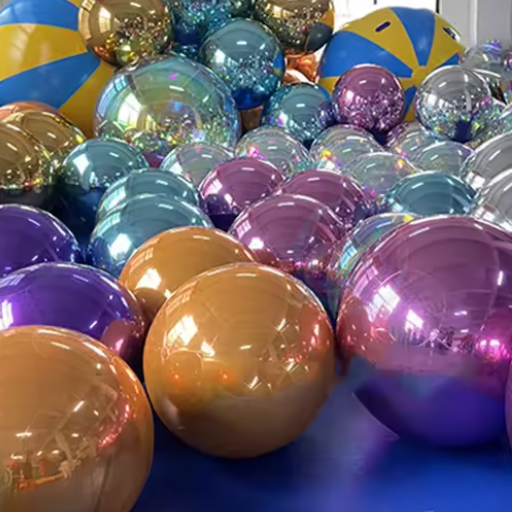Foil balloons add a touch of class to any party, making them a go-to choice for celebratory events. On the other hand, troubleshooting the best way to deflate them when the party is over may be a little challenging. Using force may damage the balloon, which ultimately defeats the purpose. If the goal is to clean up easily or to store them away, it is essential to learn the proper methods. This guide will provide a step-by-step, effortless approach to ensure you properly deflate your foil balloons while preserving their shape, ensuring they are ready for whatever decision is made later on.
What is the Best Way to Deflate a Foil Balloon?

Foil balloons can be adequately deflated by following certain dos and don’ts that can be approached systematically:
- Identifying the Self-Sealing Valve: The balloon’s valve is located on the stem and is filled through a slit. This slit is typically found around the balloon’s stem and should feel like a small flat and round opening.
- Inserting a Thin Feeder: A straw or a thin film can be pushed very lightly through the slit. Push this device far enough so that a bit of air starts to escape. Placing a straw or blade through the protrusion will keep the foil balloon safe.
- Pushing the Air Gently: After placing the straw, the next step is to press down on the balloon slightly with your hands to help allow the trapped air inside to escape through the straw. This has to be done in a downward motion.
- Pulling the Straw and Folding: When the air is placed in the storage, the straw must be pulled without force. This way, the straw will come out smoothly, and the balloon can be folded softly when the foil is removed.
Doing the steps above guarantees maximum safety to the foil balloon while ensuring it can still be used in the future.
How to Remove Air from a Foil Balloon?
| Key Point | Details |
|---|---|
|
Locate the Inflation Valve |
Find the small valve near the balloon’s tail. |
|
Insert a Straw |
Gently push a straw into the valve opening. |
|
Pass Internal Flap |
Ensure the straw passes the internal flap. |
|
Press the Balloon Gently |
Apply light pressure to release the air. |
|
Move Top to Bottom |
Squeeze air out evenly from top to bottom. |
|
Remove Straw |
Take out the straw after deflation. |
|
Fold Balloon |
Fold carefully to avoid creases or damage. |
|
Store Properly |
Keep in a cool, dry place for reuse. |
Why Gently Press the Balloon?
Step one in deflating a foil balloon correctly involves gently pressing its sides. Applying pressure evenly and lightly ensures the material is not ruined and allows the balloon to be reused. Below are five explanations that highlight the importance of this step:
- Avoids Rips and Tears
Losing a balloon due to a rupture is commonplace. Depending on how much force is applied, the foil material can be ripped, making the balloon unusable. In addition, gentle pressure reduces the chances of damage to the balloon.
- Guarantees Maximum Air Release
Consistent air release from the straw or valve, attained through gradual or controlled inflation, permits smooth deflation of the balloon, which is ideal for storage.
- Preserves Balloon’s Structure
Maintaining some form of force helps retain the balloon enclosure’s shape, allowing it to be reused successfully for other events.
- Minimizes Likelihood Of Valve Destruction
Applying strain makes the valve useless. Gentle pressure prevents breakage and improves the chances of proper reinflation.
- Maximizes Proper Storage
Properly deflated balloons can be folded and stored efficiently, saving space and making them easily accessible later.
Tips for Removing Air Without Damaging the Balloon
- Use a Straw or a Balloon Stick
A straw or balloon stick could be carefully inserted into the balloon’s valve to clear any blockages in the air’s pathway to the balloon’s exit point. This lessens the strain on the valve, minimizing the potential for damage. Using foil balloons, a straw should be positioned 2–3 inches away for unrestricted airflow.
- Using Light Strain
While gently resting their hands flat on the straw, the furthest point should be the initial squeeze on the balloon, guiding it toward the valve. This way, air is released in a relaxed manner that doesn’t impose too much tension on the material or valve. Avoid violent squeezes because of the high risk of the balloon ripping or stretching.
- Work in Clean and Stable Areas
While deflating the balloon, it must be placed on a clean, level surface. This avoids unintended cuts or punctures and ensures consistent force application without risk of the balloon being tilted or dropped.
- Avoid Overlapping the Valve
Valve mishandling consistently unknown causes is undoubtedly one of the most significant challenges to overcome when it comes to foil balloons. Improper usage has been shown to repeatedly cause a 20% failure rate if the balloon is already overinflated at the start. Valves, the prime point of weakness, always demand careful attention.
- Check if there is moisture or residue:
Absorbable negative pressure wound therapy will focus on the valve and straw, ensuring they are moisture-free and dirt-free. Moisture or debris within the valve can deteriorate the balloon material over time, making reinflation less effective. Regular checks and upkeep can ensure the durability of reusable balloons.
By following these strategies and being patient, the chances of balloon deflation with minimal damage rise considerably, allowing for storage until subsequent use.
How to Remove Air from a Balloon Without Popping It?

Remember, to take the air out of a balloon without breaking it, you should follow these procedures:
- Have a Look at the Balloon Knot
Try to loosen the knot. If untying the knot is difficult, pinch the balloon’s neck to restrict airflow.
- Gently Let the Air Out
Permit the neck of the balloon to open while holding onto most parts of the neck, allowing a small portion of air to escape. Any sudden burst of balloon pressure should be avoided.
- Guiding the Air
If possible, place a straw or similar object in the balloon’s neck. This will help remove air at a more controlled and steady rate.
These are the provided deflation methodologies to assist an individual in keeping a balloon fit for further use after proper deflation.
Understanding the Valve of Mylar Balloons
A balloon crafted from Mylar material usually features a self-sealing valve, which facilitates easy inflation and deflation, eliminating the need to tie a knot. As a result, the balloon can be conveniently stored for future use.
Steps to Deflate a Balloon Safely
| Step | Details |
|---|---|
|
1. Locate the Valve |
Find the inflation valve on the balloon. |
|
2. Insert the Straw |
Gently insert a straw into the valve. |
|
3. Pass Internal Flap |
Push the straw past the internal sealing flap. |
|
4. Release Air |
Press the balloon gently to let air escape. |
|
5. Squeeze Evenly |
Move hands top to bottom to deflate fully. |
|
6. Remove the Straw |
Take out the straw after deflation. |
|
7. Fold Balloon |
Fold carefully to avoid creases or damage. |
|
8. Store Properly |
Keep in a cool, dry place for reuse. |
Can You Reuse Mylar Balloons After Deflation?

Storing Mylar balloons is possible if the proper deflation techniques are used. This further reiterates how balloons can be stored multiple times, reinforcing the argument that Mylar balloons are an eco-friendly and cost-efficient choice.
How to Store the Balloon for Future Use
I ensure the balloon is completely deflated and fold it to prevent creasing before storing it later. Then, I put the balloon in a dry and cool location, away from sharp objects, sunlight, and anything that could potentially damage it. These steps preserve the balloon’s condition until it is needed.
Preventing Damage During Balloon Deflation
You can ensure that every Mylar balloon you have in store stays pristine by carefully following these guidelines while deflating and putting them away. These instructions will significantly help ensure that the balloon isn’t damaged in the long run.
- Deflating with a Straw
When deflating, throw away the sharp tools and use a straw instead. Straws provide a simple way for air to escape through the balloon’s valve without using overly complicated methods or cutting open the balloon itself.
- Exert a Gentle Amount of Pressure
Once the balloon is in place, let the air escape slowly by pushing down on it. You should not push in too hard; otherwise, the seams could burst or stretch, which is why care must be taken throughout the process.
- Avoid any Type of Heating method.
Mylar balloons are extremely sensitive to heat, just like other items. While the item is generally heat sensitive, any heat sources should be avoided to prevent compromising the material during heavy work.
- Work on Softer Surfaces
The step mentioned before allows the item to rest on a tablecloth or blanket without exposure to sharp objects, which tend to tear very easily. Resting the balloon on soft surfaces also ensures that it doesn’t scratch rough surfaces when it deflates.
- Check Balloon for Holes During Deflation
Points such as holes or seams allow steps to be skipped, which can damage the balloon. Therefore, the balloon must be regularly inspected for unusual tearing or holes to minimize damage during storage or reuse.
Once you master these steps, the life of a Mylar ticker balloon could be increased significantly without hindering its effectiveness or quality at any given time.
Why is a Step-by-Step Guide Important for Deflating Foil Balloons?

A detailed guide is necessary for deflating foil balloons because it has to be done safely and effectively. Clear instructions specially designed for the balloon will aid in maintaining it for subsequent events. It reduces the chances of damage, such as cuts, tears, and punctures, from dangerous missteps. Well-structured guides simplify every task, saving time, and ensuring the balloon is intact.
Common Mistakes When Trying to Deflate Foil Balloons Without Proper Guidance
| Mistake | Details |
|---|---|
|
1. Using Excessive Force |
Can tear or damage the balloon material. |
|
2. Not Finding Valve |
Leads to puncturing the balloon accidentally. |
|
3. Skipping Straw Insertion |
Prevents proper air release from the balloon. |
|
4. Pressing Unevenly |
Causes creases or uneven deflation. |
|
5. Folding Too Tightly |
Creates permanent creases or damages the material. |
|
6. Improperly Storing |
Exposure to heat or sunlight degrades quality. |
|
7. Ignoring Internal Flap |
Air remains trapped, making deflation harder. |
|
8. Rushing the Process |
Increases the risk of balloon damage or tears. |
Benefits of Following a Step-by-Step Process
By following a step-by-step method when gently removing air from foil balloons, one can pinpoint guaranteed benefits regarding efficiency and safety. A more methodical approach also minimizes damage caused by tears and punctures. Recent search data shows that foil balloons that remain improperly deflated and stored can make 30% of them completely unusable due to mismanaged and unnecessary waste, alongside added expenditure.
When proper techniques are implemented, the helium or air within balloons is released uniformly for an extended amount of time, improving their structural integrity. This is extremely important for businesses and event planners who utilize reused decorations, as it helps create savings. This also helps capture step-by-step guidance, instructing optimal storage conditions for preserving better balloon condition over months.
Finally, a deflated and structured process serves a sustainable purpose within the context of environmental impact. By succinctly following detailed instructions, businesses and individuals can improve their balloons’ usability while cutting costs and reducing wastage.
What tools can help deflate a foil balloon?

The best options when deflating a foil balloon are a straw or a balloon-inflating/deflating tool. Just slide the straw or deflator tool into the balloon’s opening until you feel the air starting to leave. Softly squeeze the balloon to let out the leftover air. These tools are low-cost and effortless, and they ensure the balloon is not damaged when it is preserved for later use.
Using a Drinking Straw for Balloon Deflation
| Step | Details |
|---|---|
|
1. Find Inflation Valve |
Locate the valve near the balloon’s tail. |
|
2. Insert the Straw |
Gently push a straw into the valve opening. |
|
3. Pass Internal Flap |
Ensure the straw passes the internal sealing flap. |
|
4. Release Air |
Press the balloon gently to let air escape. |
|
5. Squeeze Evenly |
Move hands top to bottom for complete deflation. |
|
6. Remove the Straw |
Take out the straw after deflation is complete. |
|
7. Fold Balloon |
Fold carefully to avoid creases or damage. |
|
8. Store Balloon |
Keep in a cool, dry place for reuse. |
Is an Air Pump Necessary for Deflating?
Deflating a foil balloon does not require using an air pump, as other, simpler methods can achieve the same result. Nevertheless, analyzing every option available is crucial to gauge the benefits an air pump brings to the task. The points below highlight some considerations surrounding the need for an air pump to deflate foil balloons:
- Ease of Use: Constituents such as straws or deflation tools are easier to manipulate and fit in the valve of the foil balloon than the pump’s nozzle.
- Affordability: Unlike rather pricey air pumps, straw-like deflation tools are often found in households, making them both economical and easily accessible.
- Portability: Deflation tools such as straws are slim and lightweight, making them exceptionally easy to transport compared to air pumps, which are far bulkier and less convenient to carry.
- Precision: Air pumps apply excess pressure, increasing the chances of damaging the balloon while ‘deflating’ it. Tools that control balloon deflation enable greater precision and allow for more effective air release.
- Versatility: There are air pumps with dual functionalities; however, most of them are purpose-built for inflation and do not efficiently deflate foil balloons. Pumps specially designed to deflate foil balloons are made to serve specific, better functionalities in such circumstances.
In this case, employing a pump to deflate a balloon may work, but it is not the best option. Simpler tools like straws and specialized deflation devices offer ease of use and effectiveness.
References
- Balloons (not inflated) | Transportation Security Administration – Provides guidelines on carrying balloons during travel.
- Tips on Saving Money and Energy at Home – Mentions deflation of balloons in specific scenarios.
Frequently Asked Questions (FAQ)
Q: What is the first step to deflate a foil balloon without popping it?
A: The first step is to locate the neck of the balloon where it was initially inflated. This is generally at the bottom of the balloon where the opening is situated.
Q: How do you insert the straw into the foil balloon?
A: Carefully insert a straw into the balloon’s opening, gently pushing it through the self-sealing valve until the straw is inside the balloon. This will allow you to release the air inside the balloon.
Q: Can you deflate a foil balloon filled with helium?
A: Yes, you can deflate a foil balloon filled with helium by inserting a straw into the neck of the balloon to let the air or helium out.
Q: How should the balloon be handled to avoid popping it while deflating?
A: Gently squeeze the balloon around the straw to help release the air inside without applying too much pressure, which could puncture the balloon.
Q: What should you do after the air has been released from the balloon?
A: Once the balloon is fully deflated, carefully remove the straw and store it flat in a safe place if you wish to reuse it.
Q: Is it possible to deflate a foil balloon without a straw?
A: While using a straw is the most effective method of deflating a foil balloon without puncturing it, you could also try gently squeezing the balloon at the neck to let the air out, although this may not be as efficient.
Q: Can you reuse a foil balloon after deflating it?
A: Yes, foil balloons can often be reused if they are carefully deflated and stored correctly. To reuse, simply inflate the foil balloons again using air or helium.
Q: What are the risks of not using the proper method to deflate a foil balloon?
A: Improperly deflating a foil balloon, such as puncturing it, can damage or pop the balloon, making it unusable for future occasions.
Q: Why are foil balloons a popular choice for decoration?
A: Foil balloons are made from durable materials that hold air or helium well and come in various shapes and sizes, making them ideal for balloon decor and celebrations.









